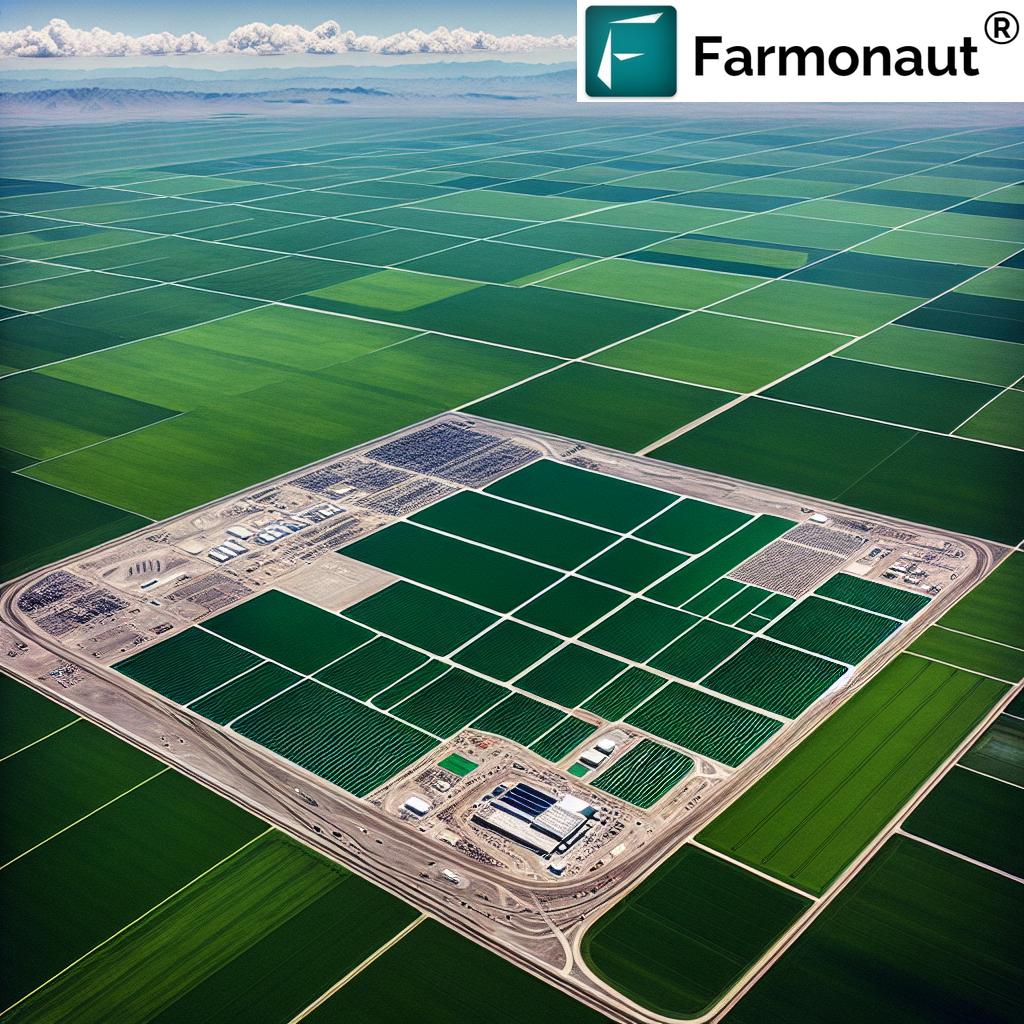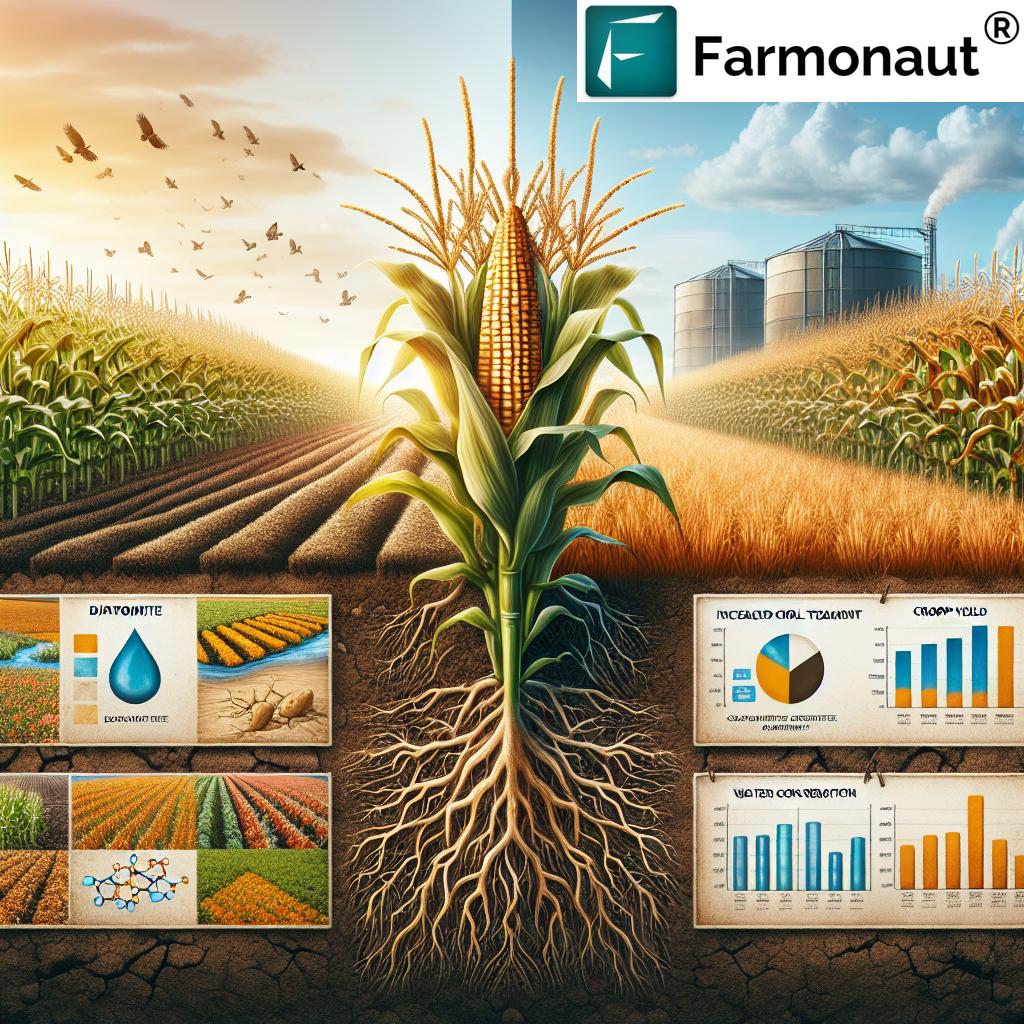Asimina triloba: 7 Key Benefits for US Sustainable Farming
Discover how Asimina triloba—commonly known as the pawpaw—is transforming sustainable agriculture, agroforestry, and food systems. This detailed guide explores the unique fruit, ecological, and economic benefits of the pawpaw tree, supported by recent research and real-world agricultural practices across the United States.
“Pawpaw trees can reduce soil erosion by up to 30% when incorporated into sustainable agroforestry systems.”
Table of Contents
- Botanical and Ecological Profile of Asimina triloba
- Cultivation Methods and Agricultural Potential
- Ecosystem Services and Environmental Significance
- Market, Economic, and Future Prospects
- Benefits Comparison Table: 7 Key Advantages of Asimina triloba
- In-Depth: 7 Key Benefits of Pawpaw for US Sustainable Farming
- Farmonaut’s Role in Sustainable Pawpaw Farming
- Frequently Asked Questions
- Conclusion
Botanical and Ecological Profile of Asimina triloba
Asimina triloba, or the pawpaw, is a deciduous small tree or large shrub native to the temperate regions of eastern United States, making it highly suitable for agricultural and agroforestry systems within USDA Hardiness Zones 5 through 9. This unique species grows between 15 to 30 feet tall and holds the title of the largest edible fruit native to North America. The fruit resembles a large mango or custard apple, with a sweet, tropical flavor likened to a blend of banana, mango, and melon.
Pawpaw flowers bloom in early spring, showcasing large, maroon petals that attract pollinators, mainly native flies and beetles. Despite their allure, specialized pollination requirements often lead commercial growers to practice hand pollination for improved fruit set and yield.
In nature, pawpaw trees thrive in rich, well-drained floodplain soils and shaded forest understories. Their remarkable shade tolerance makes them excellent candidates for agroforestry systems and riparian buffer zones. This adaptability supports sustainable agricultural practices, where pawpaw can integrate with managed woodlands and other food production systems.
- Scientific name: Asimina triloba
- Family: Annonaceae
- Native range: Eastern North America
- Growth zones: USDA zones 5–9
- Mature height: Typically 15–30 feet tall
- Fruit: Largest edible native fruit in the US; resembles mango/custard apple
- Flavor: Sweet, tropical; a blend of banana, mango, and melon
- Flower color: Deep maroon
- Pollinators: Flies, beetles; often hand-pollinated commercially
- Ecological significance: Shade-tolerant, supports riparian and forest ecosystems
Pawpaw: A Unique and Underappreciated Native Fruit
While Asimina triloba is commonly known as pawpaw, it remains one of the most underappreciated fruit trees in US agriculture. This perception is rapidly changing as interest grows in diversifying crop portfolios and sustainable farming practices. Its large, nutrient-rich fruit, low input needs, and ecological contributions make it uniquely positioned for adoption in modern, sustainable food systems.
Cultivation Methods and Agricultural Potential of Asimina triloba
Cultivating Asimina triloba has transitioned from wild harvesting to more controlled and productive methods in recent years. Traditionally, pawpaw fruit production was limited to foragers and local food enthusiasts collecting from naturally growing trees. However, recent advances in propagation, grafting, and cultivar development have unlocked its commercial farming potential.
- Propagation: Primarily via grafting from select cultivars for superior fruit quality and yield.
- Fruit-bearing age: Trees begin to produce after 3–5 years, with full maturity at 7–8 years.
- Input requirements: Minimal; pawpaw is naturally pest- and disease-resistant compared to many traditional fruit crops.
- Pawpaw in agroforestry: The tree’s tolerance to shade and adaptability makes it ideal for forest farming and integrated food and timber systems.
- Yield: High potential—can reach up to 15,000 pounds per acre upon maturity.
- Harvesting: Can be challenging due to delicate fruit skin and short post-harvest shelf-life, but innovations in storage and processing are expanding its market reach.
“Asimina triloba fruit yields can reach 15,000 pounds per acre, offering significant economic potential for U.S. farmers.”
Why Pawpaw Trees Align with Sustainable Agriculture Practices
- Low chemical input: Less reliant on pesticides and fertilizers, reducing soil and water contamination.
- Natural pest resistance: Leaves contain compounds that deter many insects and herbivores.
- Supports permaculture: Integrates well in polycultures and food forests, enhancing ecosystem resilience.
- Niche market potential: The fruit’s appeal as a healthy, native, locally grown crop supports farm diversification and access to specialty markets.
- Food system resilience: By branching out beyond commodity crops, farmers insulate themselves against market and climate volatility—a key sustainable farming strategy for 2026 and beyond.
Looking to monitor soil moisture, crop health, or NDVI for your pawpaw or diversified food forest? Farmonaut’s large-scale farm management platform provides satellite-driven real-time insights to optimize tree health, water use, and sustainable yields, all accessible from your desktop or smartphone.
Ecosystem Services and Environmental Significance of Pawpaw Trees
Asimina triloba is a cornerstone in delivering valuable ecosystem services on working lands and in managed woodlands. When planted in riparian areas (river and stream banks), these trees stabilize soil and reduce erosion—an essential role for sustainable US farming in both upland and bottomland regions. Their deep root systems improve soil structure and mitigate water runoff, while also filtering pollutants and enhancing local water quality.
- Soil stabilization and erosion control: Pawpaw roots networks lock in topsoil and protect vulnerable slopes.
- Biodiversity support: The tree provides shelter and food for a wide range of pollinators, birds, and mammals such as raccoons and foxes.
- Habitat creation: Dense pawpaw patches enrich forest understories and promote complex, layered plant communities.
- Shade tolerance and forest integration: Successfully produces in partially shaded environments, increasing forest farm biodiversity and land-use efficiency.
- Carbon sequestration: As a perennial, woody crop, pawpaw trees actively draw down atmospheric CO2, supporting carbon farming goals.
- Explore Farmonaut’s carbon footprint monitoring tool for data-driven strategies to track your agroforestry project’s environmental progress and sustainability compliance.
- Water quality enhancement: By slowing runoff in riparian buffers, pawpaws help reduce agrochemical leaching and sedimentation downstream.
With droughts, floods, and climate extremes intensifying across North America, integrating diversified, native species like pawpaw into sustainable food systems not only safeguards yields but also builds long-term ecological and economic resilience.
Pawpaw agroforestry systems further contribute to landscape-scale environmental restoration through sustainably managed woodlands and buffering riparian habitats, supporting both conservation goals and farm productivity.
Market, Economic, and Future Prospects for Asimina triloba in US Agriculture
The current pawpaw industry is best described as niche but rapidly expanding. Innovations in post-harvest handling, value-added processing, cold storage, and varietal breeding are directly addressing the challenge of pawpaw’s delicate skin and short shelf life.
- Market appeal: Pawpaws are sought after at farmer’s markets, local food hubs, and specialty grocers, often commanding premium prices due to their rarity and flavor profile.
- Value-added products: The fruit’s tropical notes and creamy texture are ideal for making jams, preserves, ice creams, craft beverages, and baked goods.
- Income diversification: Adding pawpaw to existing operations provides another crop stream, reducing risk exposure and increasing overall farm resilience.
- Research and development: Breeding programs focus on developing improved cultivars with longer shelf life, enhanced flavor, and greater yield, unlocking more commercial production potential.
- Mechanization opportunities: Advances in mechanized harvesting and processing will help larger operations reach broader markets by 2026 and beyond.
Connecting your farm’s sustainability journey to local consumers? Consider Farmonaut’s blockchain-based traceability platform, which enhances transparency and builds trust by digitally verifying every step of your pawpaw—‘from orchard to table’.
In summary, commercial pawpaw production is on the cusp of new growth through targeted market development, enhanced harvest and storage techniques, and expanded farmer adoption driven by the economic and ecological significance of this native tree.
Benefits Comparison Table: 7 Key Advantages of Asimina triloba for Sustainable Farming
| Benefit | Description | Estimated Impact | Relevance to US Sustainable Farming |
|---|---|---|---|
| Soil Stabilization | Deep roots hold soil and reduce erosion in riparian and sloped areas. | Up to 30% less soil loss | Protects farmland, water quality, and flood resilience. |
| Native Pest Resistance | Foliage contains compounds that deter most insects and diseases. | Up to 60% reduction in chemical inputs | Low pesticide need, supports pollinator and soil life health. |
| High Fruit Yield | Orchards can output large quantities of fruit per acre at maturity. | Up to 15,000 lbs/acre/year | Significant revenue and market potential for diversified farms. |
| Carbon Sequestration | Perennial, woody growth forms store atmospheric carbon long term. | 2–4 tons CO2 sequestered/acre/year | Mitigates farm emissions, supports carbon trading/credits. |
| Biodiversity Enhancement | Provides habitat and food for pollinators, birds, and mammals. | 10–25% increase in local biodiversity indices | Stronger, more resilient on-farm and local ecosystems. |
| Shade & Forest Integration | Thrives in mixed-species, shaded, or layered agroforestry systems. | Increases land-use efficiency by 15%+ | Boosts land productivity, supports woodland agroforestry. |
| Niche Market Value | Premium prices for exotic, healthy, locally produced fruit. | Up to 3–5× higher revenue than standard tree fruits | Supports rural economies, “buy local” initiatives, and farm viability. |
In-Depth: 7 Key Benefits of Asimina triloba for US Sustainable Farming
1. Soil Stabilization & Erosion Control
The deep, fibrous root system of pawpaw forms a strong anchor against soil erosion—in riparian buffers, forest margins, and sloped farmland. This not only preserves valuable topsoil but also reduces nutrient runoff into waterways, boosting long-term productivity. For US farms in erosion-prone areas, incorporating pawpaw into diversified agroforestry can cut soil loss by up to 30%, according to recent sustainable farming research.
- Protects critical farmland and waterways
- Improves resilience during storms and heavy rain events
- A key native solution for soil and water conservation in the eastern US and similar temperate climates
2. Native Pest Resistance & Low Chemical Input
Pawpaw leaves are rich in acetogenins—natural insecticidal compounds—making this species naturally resistant to many pests and diseases. Growers significantly reduce reliance on chemical pesticides, which translates to healthier soil, fewer impacts on beneficial organisms, and lower production costs.
- Supports integrated pest management within local food production systems
- Encourages a cleaner, biodiversity-friendly farm ecosystem
- Positions pawpaw well for organic and sustainable certification schemes
3. High Fruit Yield and Economic Potential
Mature pawpaw trees offer some of the highest fruit yields of any temperate fruit crop, with commercial orchards capable of producing up to 15,000 pounds per acre. Its short time to first harvest (3–5 years) and strong consumer demand for exotic, healthy fruits make it an attractive addition to diversified farm portfolios focused on both local food security and economic development.
- High returns per acre compared to other native or specialty fruits
- Expanding opportunities for value-added products in US local markets
- Makes pawpaw a promising investment crop for forward-looking US farmers
4. Carbon Sequestration & Climate Mitigation
As a hardy, perennial woody species, pawpaw sequesters atmospheric carbon—contributing to farm-level and regional climate mitigation strategies. When planted in forest buffers or in mixed-species agroforestry, pawpaw increases the capacity for carbon drawdown by an estimated 2–4 tons CO2 per acre annually.
- Supports climate-smart agriculture programs and carbon credit systems
- Provides long-term environmental benefits while producing marketable fruit
- Helps farmers participate in emerging carbon marketplaces
5. Biodiversity Enhancement & Wildlife Support
Dense pawpaw patches provide critical habitat for pollinators, birds, and mammals. Flowers attract unique insect pollinators (flies, beetles) in early spring, while ripening fruit feed numerous native wildlife. This supports increased biodiversity indices—studies estimate a 10–25% rise in local species richness where pawpaw is established in agroforestry systems.
- Integrates well in multilayer forest food webs
- Promotes ecological health and functional on-farm landscapes
- Adds value for conservation-driven landowners
6. Shade Tolerance & Forest Integration
Unlike many fruit crops, pawpaw thrives in partial to full shade—making it ideal for forest farming, woodland pastures, and layered “food forest” systems. This allows US farmers to use understory and edge spaces efficiently, diversifying land use and increasing the productivity of acres otherwise underutilized.
- Optimizes land for both timber and food production
- Great fit for riparian buffers, silvopasture, or ecological restoration projects
- Supports income streams throughout different forested environments
7. Niche Market Value & Rural Revitalization
Pawpaw is a star in specialty and local markets, prized for its unique flavor, nutritional profile, and indigenous heritage. Farmers selling fresh fruit, processed goods, or pawpaw saplings can often secure 3–5 times the revenue of traditional tree fruit on a per-pound basis.
- Supports rural economic diversification and job creation
- Aligns with consumer trends toward authentic, American regional foods
- Opens the door for agritourism, farm-to-table, and sustainable brand storytelling
To further leverage pawpaw’s economic and ecological promise, explore Farmonaut’s crop loan and insurance verification—satellite-based tools that make pawpaw farming more accessible and resilient for growers by streamlining finance and risk management.
Farmonaut’s Role in Sustainable Pawpaw Farming
At Farmonaut, our mission is to democratize access to satellite-driven insights for agriculture—empowering pawpaw farmers and agroforestry practitioners with accurate, timely data to optimize their production, reduce environmental impact, and grow resilient operations for 2026 and beyond. Here’s how our technologies align with sustainable pawpaw farming:
- Satellite Crop Monitoring: Real-time tracking of canopy vigor, soil moisture, and plant health—identifying early stress, water issues, or pest/disease outbreaks even in mixed-species setups.
- AI Advisory (Jeevn): Our AI system analyzes satellite weather data to provide site-specific recommendations for pawpaw orchard management, irrigation, and risk alerts—including prediction of pollination timing or yield estimates.
- Environmental Impact Tools: Monitor carbon footprint, water use, and soil health in real time—essentials for compliance and sustainability certification in North American markets.
- Blockchain Traceability: Physically authenticates pawpaw’s journey from orchard to market, adding transparency and value in marketing native “farm-to-table” fruit.
- Fleet & Resource Management: For farms scaling up, our tools help optimize logistics, machinery usage, and post-harvest operations—lowering operational costs.
For developers: Integrate pawpaw/Asimina triloba field-level insights directly into your agtech or sustainability solution via our public API. Find API documentation and technical guides here.
If your vision includes mass crop plantation forest advisory for underutilized species like pawpaw, Farmonaut’s platform is built for scale—serving user needs from small U.S. farms to regional agencies launching public environmental initiatives.
Frequently Asked Questions
What is Asimina triloba and why is it important for sustainable agriculture in the United States?
Asimina triloba, also known as pawpaw, is a native deciduous tree producing the largest edible fruit indigenous to North America. Its resilience, ecological services, low input requirements, and high-value fruit make it uniquely suited for sustainable farming and agroforestry in temperate US regions, especially in USDA zones 5–9.
How long does it take for pawpaw trees to bear fruit?
Grafted pawpaw trees generally start producing fruit after 3–5 years, reaching full maturity and optimal yields around 7–8 years.
Can pawpaw be integrated with other crops in forest farming systems?
Yes. Pawpaw’s shade tolerance allows it to thrive under taller trees or as an understory crop in woodland, silvopasture, and mixed-species agroforestry, maximizing land productivity and biodiversity.
What makes pawpaw resistant to pests compared to other fruit trees?
Pawpaw leaves contain natural acetogenins, compounds shown to deter many native insects and pests, lowering the need for chemical pesticides and supporting pollinator health.
What are some common uses for pawpaw fruit?
Beyond fresh eating, pawpaw fruit is popular in jams, preserves, smoothies, baked goods, specialty desserts, and innovative products thanks to its creamy texture and tropical flavor.
How can I monitor my pawpaw orchard’s health from anywhere?
Use Farmonaut’s satellite crop monitoring tools to access real-time NDVI, soil health data, and manage agroforestry inputs for pawpaw production from any device—boosting productivity and sustainability.
Are there financing or insurance tools specifically for pawpaw or agroforestry farmers?
Yes. Farmonaut provides satellite-based crop verification for loans and insurance, reducing administrative burdens and increasing farm access to critical financial resources.
Conclusion: Asimina triloba’s Transformative Role in US Sustainable Farming
Asimina triloba stands out as a multifunctional, resilient tree crop offering unique ecological, economic, and agricultural benefits for sustainable food and forestry systems. Its ability to stabilize soil, enhance native biodiversity, resist pests, yield premium fruit, and fit seamlessly within diversified land use strategies positions it as a key species for US farmers, landowners, and conservation practitioners looking to future-proof operations in 2026 and beyond.
At Farmonaut, we believe technology and tradition are best paired for the future of food and environmental stewardship. By adopting pawpaw into your portfolio and leveraging advanced satellite, AI, and blockchain solutions, you are building both resilient rural economies and healthier, more sustainable landscapes.
Embrace Asimina triloba—our native treasure—for a future where agroforestry, economic prosperity, and ecological health go hand in hand.















